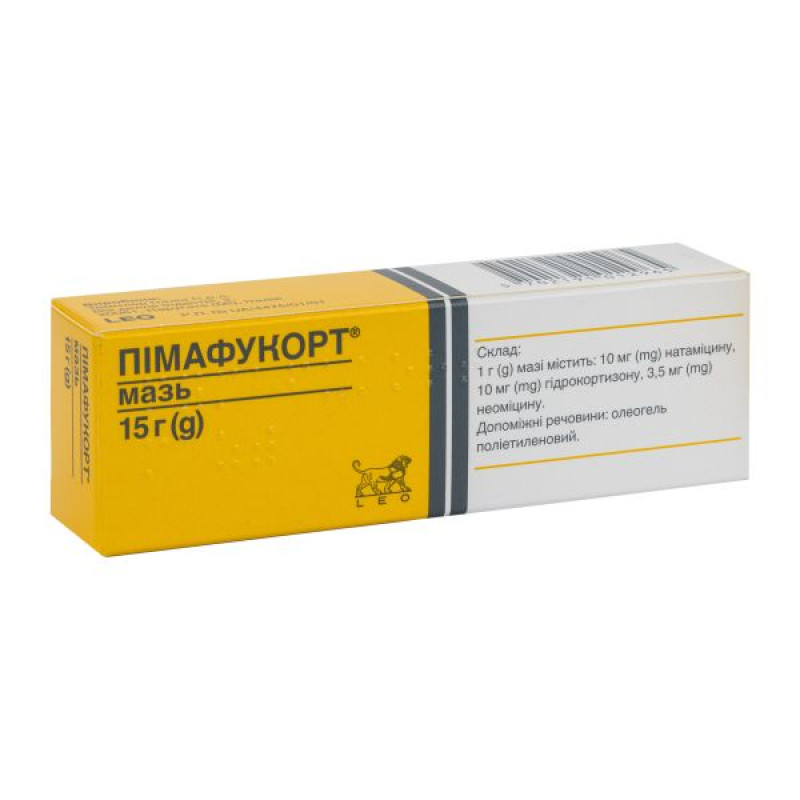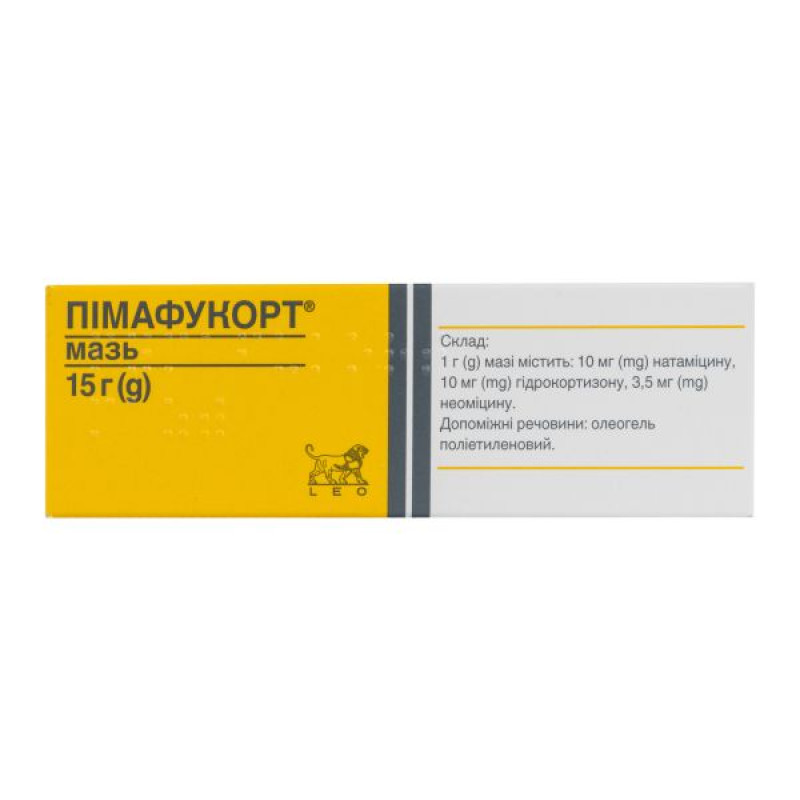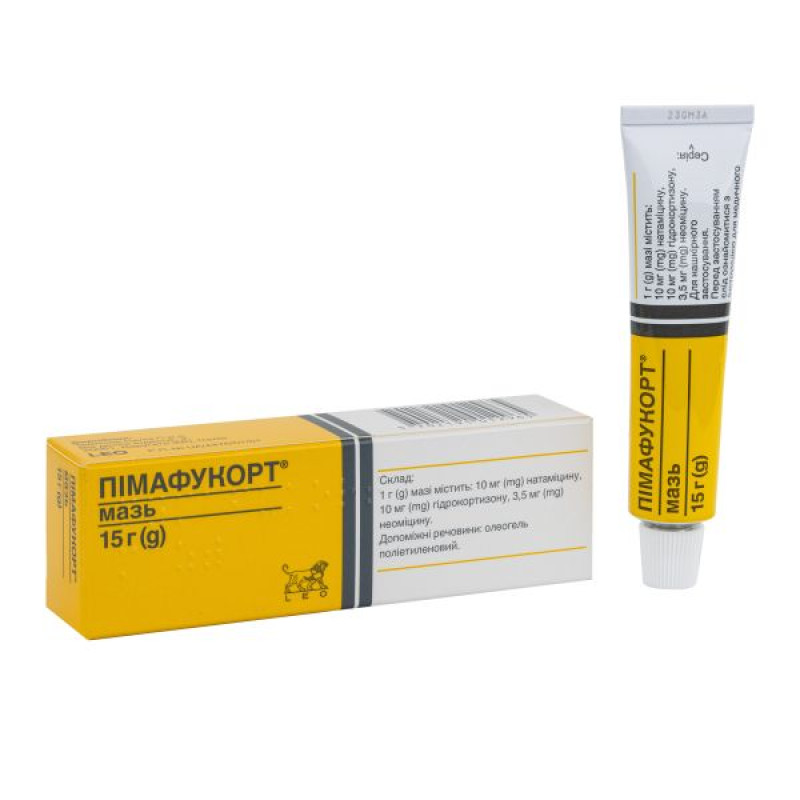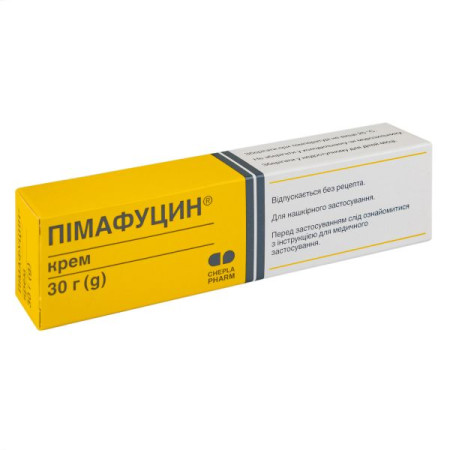Pimafucort ointment tube 15 g

Instructions for Pimafucort ointment tube 15 g
Composition
active ingredients: natamycin, hydrocortisone, neomycin;
1 g of ointment contains 10 mg of natamycin, 10 mg of hydrocortisone, 3.5 mg of neomycin;
excipients: polyethylene oleogel.
Dosage form
Ointment.
Main physicochemical properties: white to light yellow ointment.
Pharmacotherapeutic group
Corticosteroids for use in dermatology. Corticosteroids in combination with antibiotics. ATX code D07C A01.
Pharmacological properties
Pharmacodynamics
Pimafucort® is a combination drug containing the active ingredients: hydrocortisone, neomycin, and natamycin.
Hydrocortisone is a corticosteroid that has anti-inflammatory and vasoconstrictive effects. Hydrocortisone suppresses the inflammatory response and reduces the severity of symptoms of various skin diseases that often cause itching, but it does not eliminate the diseases that caused them.
Neomycin is a broad-spectrum antibiotic, active against some gram-positive (staphylococci, enterococci) and gram-negative (Klebsiella spp., Proteus spp., Escherichia coli) bacteria. Pseudomonas aeruginosa is resistant to neomycin in vitro.
Natamycin belongs to the macrolide group of polyene antibiotics and has fungicidal activity against infections caused by fungi, in particular Candida spp. It is not known whether other types of fungi are resistant to natamycin.
Cross-resistance between neomycin and other aminoglycoside antibiotics may occur through the development of plasmids whose enzymes deactivate aminoglycosides and reduce cell membrane permeability, resulting in reduced aminoglycoside effects due to impaired energy metabolism or ribosomal mutation, although the latter mechanism is rare.
Pharmacokinetics
Absorption
Natamycin and neomycin are practically not absorbed through intact skin and mucous membranes. Neomycin may be slightly absorbed through damaged skin, wounds and ulcers. About 1–3% of hydrocortisone is absorbed through intact skin; in eczema, the amount of hydrocortisone absorbed increases by twofold, in infectious skin lesions – by 5 times. In children, the degree of absorption decreases with age.
Indication
Short-term treatment of superficial dermatoses responsive to corticosteroid therapy, complicated by secondary bacterial and/or fungal infection (especially caused by fungi of the genus Candida) sensitive to neomycin and natamycin.
Contraindication
Since Pimafucort® contains hydrocortisone (a weak corticosteroid), there are the following contraindications:
skin diseases caused by primary bacterial infections; primary infections caused by fungi and yeasts; parasitic infections (including significant and severe skin lesions); viral infections; skin wounds and ulcers, trophic ulcers, burns; adverse reactions caused by corticosteroids (perioral dermatitis, striae); ichthyosis, juvenile plantar dermatosis, acne vulgaris, rosacea, fragility of blood vessels in the skin, skin atrophy.
Pimafucort® should not be used in the external auditory canal in case of perforation of the eardrum.
In addition, Pimafucort® should not be used in case of hypersensitivity to neomycin, natamycin, aminoglycosides, corticosteroids (which occurs very rarely) or any of the excipients.
Interaction with other medicinal products and other types of interactions
There are no data on drug interactions of Pimafucort®.
Application features
The risk of local adverse reactions increases with increasing duration of treatment. The use of occlusive dressings (cellophane) or application to skin folds increases this risk.
The skin of the face, scalp and genitals is particularly sensitive to the occurrence of local reactions.
Application to the face, flexural surfaces, and other areas with thin skin may lead to skin atrophy and increased absorption of the drug.
Topical corticosteroids can be dangerous for patients with psoriasis for a number of reasons, including rebound syndrome due to tolerance, the risk of generalized pustular psoriasis, or local systemic toxicity due to impaired skin barrier function. Steroids may be used for scalp psoriasis or chronic scaly psoriasis of the hands and feet. Close monitoring is important.
If used inappropriately, bacterial, parasitic, fungal and viral infections may be masked and/or exacerbated.
The drug should not be applied to the eyelids due to the possibility of contact with the conjunctiva and an increased risk of developing glaucoma or subcapsular cataracts.
When applying Pimafucort® to large areas of skin, when used in children or when using an occlusive dressing (i.e. in cases where experience of use is limited), patients should be informed of the possibility of suppression of the function of the adrenal cortex.
Visual disturbances may occur with systemic and topical corticosteroids. If a patient presents with symptoms such as blurred vision or other visual disturbances, an ophthalmologist should be consulted to evaluate possible causes, including cataracts, glaucoma, or rare diseases such as central serous chorioretinopathy (CSR), which have been reported following systemic or topical corticosteroid use.
There is a possibility of both cross-sensitization between neomycin and chemically related antibiotics such as kanamycin, paromycin, and gentamicin, and cross-resistance between neomycin and other aminoglycosides.
Thus, to maintain the necessary levels of aminoglycosides when they are used systemically, it is necessary to adhere as closely as possible to the indications for use and duration of treatment.
Long-term treatment and application to wounds or damaged skin should be avoided due to the theoretical risk of ototoxicity and nephrotoxicity due to absorption of neomycin.
The use of a combination of corticosteroids, antifungals and antibiotics is indicated only in exceptional circumstances. A correct diagnosis is necessary to exclude the possibility of resistance of microorganisms. In some cases, it is necessary to use two or more active substances. However, often the desired result can be achieved using a preparation containing a single active substance.
In the event of superinfections or excessive growth of fungal infection, treatment with the drug should be discontinued and appropriate measures should be taken.
Special caution should be exercised when administering aminoglycoside-containing drugs to patients with renal insufficiency.
Ability to influence reaction speed when driving vehicles or other mechanisms
There are no data on the effect of the drug Pimafucort® on the ability to drive or use machines, and such an effect is not expected.
Use during pregnancy or breastfeeding
Pregnancy
Limited data suggest that natamycin use during pregnancy does not increase the risk of birth defects. Systemic absorption of natamycin is minimal when applied topically to small areas. There are no animal studies with natamycin.
Ototoxicity has been reported with systemic use of aminoglycosides during pregnancy. Systemic absorption of aminoglycosides is minimal when applied topically to small areas. Animal studies have shown reproductive toxicity with neomycin.
In animals, nephrotoxicity to the fetus has been observed after prenatal use of aminoglycosides. Hearing loss has been observed in the offspring of rats exposed prenatally to neomycin. Topical administration of corticosteroids to pregnant animals at high doses may cause such malformations during fetal development as cleft palate and intrauterine growth retardation. The data from preclinical studies do not add new information to the already existing experience with the use of the drug in clinical practice.
Corticosteroids can cross the placenta. To date, no teratogenic effects have been observed in humans, as observed in animal studies. With systemic use of glucocorticosteroids in high doses, effects on the fetus/neonate have been observed (intrauterine growth retardation, adreno-suppression). Data on the external use of glucocorticosteroids in humans during pregnancy are limited. Their minimal systemic absorption must be taken into account. Glucocorticosteroids of weak and moderate activity (class I and II), such as hydrocortisone, can be used in short courses on limited areas of the skin. The effects described above cannot be excluded with prolonged use or application to large areas of damaged skin.
Pimafucort® can be used during pregnancy in short courses on small areas of skin. Long-term use or application to large areas of damaged skin is possible only in extreme cases.
Breast-feeding
There is no information on the possible secretion of natamycin into breast milk. When applied in short courses to small areas of skin, glucocorticosteroids and neomycin are excreted into breast milk only in small amounts.
Pimafucort® can be used during breastfeeding in short courses on small areas of skin. Breastfeeding is not recommended for prolonged use or application to large areas of damaged skin.
Method of administration and doses
The drug should be applied in a thin layer to the affected areas of the skin 2–4 times a day. The duration of the course of treatment is determined individually by the doctor depending on the nature of the disease. The course of treatment, as a rule, should not exceed 14 days.
Pimafucort® in this dosage form is used primarily for the treatment of chronic skin diseases in which lesions occur, accompanied by peeling, dryness, cracks, and seborrhea.
Children
The drug should be used in children over 1 year of age, under the supervision of a physician.
Overdose
There are no data on cases of overdose. There is a theoretical possibility of ototoxic effects of neomycin in case of application of the drug to the area of the external auditory canal in the presence of perforation of the eardrum and direct action of neomycin on the middle ear. In some cases, if the contents of the entire package of the drug Pimafucort® are accidentally ingested, the drug is likely to be tolerated without the development of toxic effects.
Adverse reactions
Rare (≥ 1/10,000 to < 1/1,000)
From the endocrine system
Adrenocortical suppression due to topical use of corticosteroids is rarely observed in adults. It is not expected to occur as a result of the use of Pimafucort®. The possibility of developing systemic effects increases when using an occlusive dressing, applying to large areas of skin, using for a long time, and in children.
Skin and subcutaneous tissue disorders
When using the drug Pimafucort®, a slight skin irritation may initially occur. This does not require discontinuation of treatment.
Hypersensitivity reactions, burning and irritation of the skin, dermatitis, eczema, contact dermatitis; allergic contact reactions, especially to neomycin; side effects of corticosteroids may occur, but the likelihood of their occurrence with hydrocortisone is lower than with corticosteroids of higher potency: skin atrophy, often irreversible, accompanied by thinning of the skin, telangiectasias, purpura and striae; rosacea-like and perioral dermatitis, accompanied or not accompanied by skin atrophy; "ricochet" effect, which can cause steroid dependence; delayed wound healing; depigmentation, hypertrichosis.
The risk of local adverse reactions increases with increasing duration of treatment. The use of occlusive dressings (cellophane) or application to skin folds increases this risk. The skin of the face, scalp and genitals is particularly susceptible to local reactions.
If used inappropriately, bacterial, parasitic, fungal and viral infections may be masked and/or exacerbated.
Very rare (<1/10,000)
On the part of the organs of vision: increased intraocular pressure, increased risk of cataract development.
Frequency not known (cannot be estimated from available data)
From the organs of vision: blurred vision.
Skin and subcutaneous tissue disorders: skin rash, itching, pustular acne.
The risk of systemic effects increases in the following cases: application with a bandage (cellophane bandage) or in skin folds; application to large areas of skin; long-term treatment; application to children (children are extremely sensitive due to their thinner skin and relatively large surface area); the presence of components or excipients that enhance penetration through the stratum corneum and/or enhance the effect of the active substance.
The risk of local adverse reactions increases with increasing drug potency and duration of treatment. Application under a bandage (cellophane bandage) or in skin folds increases this risk. The skin of the face and scalp, as well as the genitals, is particularly sensitive. In case of inappropriate use, as well as in the presence of bacterial, parasitic, fungal or viral infections, the manifestations of these diseases may be masked and/or aggravated.
Expiration date
5 years.
Storage conditions
Store at a temperature not exceeding 25 ° C. Keep out of the reach of children.
Packaging
15 g of ointment in a tube; 1 tube in a cardboard box.
Vacation category
According to the recipe.
Producer
Temmler Italia S.r.l.
Location of the manufacturer and its business address
Via delle Industri, 2, 20061, Carugate (MI), Italy.
There are no reviews for this product.
There are no reviews for this product, be the first to leave your review.
No questions about this product, be the first and ask your question.











